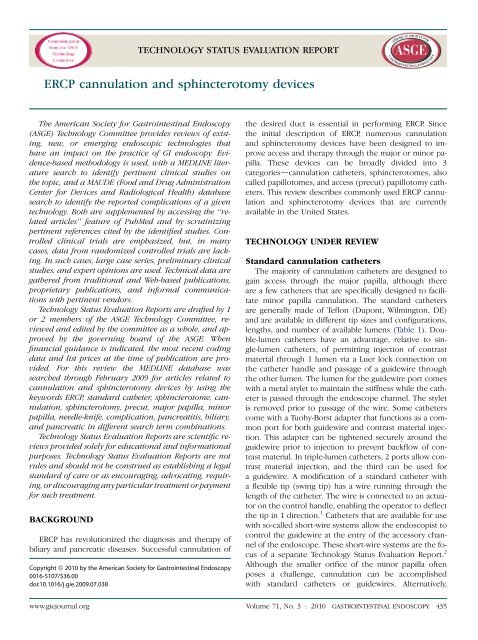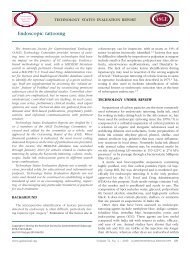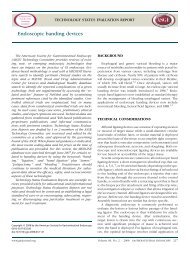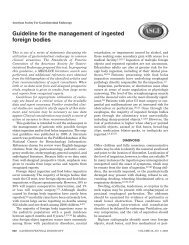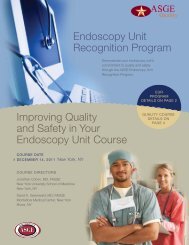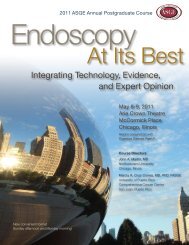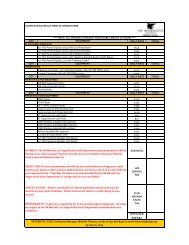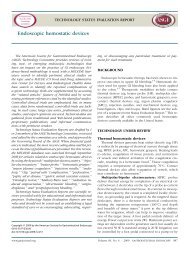ERCP cannulation and sphincterotomy devices - American Society ...
ERCP cannulation and sphincterotomy devices - American Society ...
ERCP cannulation and sphincterotomy devices - American Society ...
Create successful ePaper yourself
Turn your PDF publications into a flip-book with our unique Google optimized e-Paper software.
TECHNOLOGY STATUS EVALUATION REPORT<br />
<strong>ERCP</strong> <strong>cannulation</strong> <strong>and</strong> <strong>sphincterotomy</strong> <strong>devices</strong><br />
The <strong>American</strong> <strong>Society</strong> for Gastrointestinal Endoscopy<br />
(ASGE) Technology Committee provides reviews of existing,<br />
new, or emerging endoscopic technologies that<br />
have an impact on the practice of GI endoscopy. Evidence-based<br />
methodology is used, with a MEDLINE literature<br />
search to identify pertinent clinical studies on<br />
the topic, <strong>and</strong> a MAUDE (Food <strong>and</strong> Drug Administration<br />
Center for Devices <strong>and</strong> Radiological Health) database<br />
search to identify the reported complications of a given<br />
technology. Both are supplemented by accessing the ‘‘related<br />
articles’’ feature of PubMed <strong>and</strong> by scrutinizing<br />
pertinent references cited by the identified studies. Controlled<br />
clinical trials are emphasized, but, in many<br />
cases, data from r<strong>and</strong>omized controlled trials are lacking.<br />
In such cases, large case series, preliminary clinical<br />
studies, <strong>and</strong> expert opinions are used. Technical data are<br />
gathered from traditional <strong>and</strong> Web-based publications,<br />
proprietary publications, <strong>and</strong> informal communications<br />
with pertinent vendors.<br />
Technology Status Evaluation Reports are drafted by 1<br />
or 2 members of the ASGE Technology Committee, reviewed<br />
<strong>and</strong> edited by the committee as a whole, <strong>and</strong> approved<br />
by the governing board of the ASGE. When<br />
financial guidance is indicated, the most recent coding<br />
data <strong>and</strong> list prices at the time of publication are provided.<br />
For this review the MEDLINE database was<br />
searched through February 2009 for articles related to<br />
<strong>cannulation</strong> <strong>and</strong> <strong>sphincterotomy</strong> <strong>devices</strong> by using the<br />
keywords <strong>ERCP</strong>, st<strong>and</strong>ard catheter, sphincterotome, <strong>cannulation</strong>,<br />
<strong>sphincterotomy</strong>, precut, major papilla, minor<br />
papilla, needle-knife, complication, pancreatitis, biliary,<br />
<strong>and</strong> pancreatic in different search term combinations.<br />
Technology Status Evaluation Reports are scientific reviews<br />
provided solely for educational <strong>and</strong> informational<br />
purposes. Technology Status Evaluation Reports are not<br />
rules <strong>and</strong> should not be construed as establishing a legal<br />
st<strong>and</strong>ard of care or as encouraging, advocating, requiring,<br />
or discouraging any particular treatment or payment<br />
for such treatment.<br />
BACKGROUND<br />
<strong>ERCP</strong> has revolutionized the diagnosis <strong>and</strong> therapy of<br />
biliary <strong>and</strong> pancreatic diseases. Successful <strong>cannulation</strong> of<br />
Copyright ª 2010 by the <strong>American</strong> <strong>Society</strong> for Gastrointestinal Endoscopy<br />
0016-5107/$36.00<br />
doi:10.1016/j.gie.2009.07.038<br />
the desired duct is essential in performing <strong>ERCP</strong>. Since<br />
the initial description of <strong>ERCP</strong>, numerous <strong>cannulation</strong><br />
<strong>and</strong> <strong>sphincterotomy</strong> <strong>devices</strong> have been designed to improve<br />
access <strong>and</strong> therapy through the major or minor papilla.<br />
These <strong>devices</strong> can be broadly divided into 3<br />
categoriesd<strong>cannulation</strong> catheters, sphincterotomes, also<br />
called papillotomes, <strong>and</strong> access (precut) papillotomy catheters.<br />
This review describes commonly used <strong>ERCP</strong> <strong>cannulation</strong><br />
<strong>and</strong> <strong>sphincterotomy</strong> <strong>devices</strong> that are currently<br />
available in the United States.<br />
TECHNOLOGY UNDER REVIEW<br />
St<strong>and</strong>ard <strong>cannulation</strong> catheters<br />
The majority of <strong>cannulation</strong> catheters are designed to<br />
gain access through the major papilla, although there<br />
are a few catheters that are specifically designed to facilitate<br />
minor papilla <strong>cannulation</strong>. The st<strong>and</strong>ard catheters<br />
are generally made of Teflon (Dupont, Wilmington, DE)<br />
<strong>and</strong> are available in different tip sizes <strong>and</strong> configurations,<br />
lengths, <strong>and</strong> number of available lumens (Table 1). Double-lumen<br />
catheters have an advantage, relative to single-lumen<br />
catheters, of permitting injection of contrast<br />
material through 1 lumen via a Luer lock connection on<br />
the catheter h<strong>and</strong>le <strong>and</strong> passage of a guidewire through<br />
the other lumen. The lumen for the guidewire port comes<br />
with a metal stylet to maintain the stiffness while the catheter<br />
is passed through the endoscope channel. The stylet<br />
is removed prior to passage of the wire. Some catheters<br />
come with a Tuohy-Borst adapter that functions as a common<br />
port for both guidewire <strong>and</strong> contrast material injection.<br />
This adapter can be tightened securely around the<br />
guidewire prior to injection to prevent backflow of contrast<br />
material. In triple-lumen catheters, 2 ports allow contrast<br />
material injection, <strong>and</strong> the third can be used for<br />
a guidewire. A modification of a st<strong>and</strong>ard catheter with<br />
a flexible tip (swing tip) has a wire running through the<br />
length of the catheter. The wire is connected to an actuator<br />
on the control h<strong>and</strong>le, enabling the operator to deflect<br />
the tip in 1 direction. 1 Catheters that are available for use<br />
with so-called short-wire systems allow the endoscopist to<br />
control the guidewire at the entry of the accessory channel<br />
of the endoscope. These short-wire systems are the focus<br />
of a separate Technology Status Evaluation Report. 2<br />
Although the smaller orifice of the minor papilla often<br />
poses a challenge, <strong>cannulation</strong> can be accomplished<br />
with st<strong>and</strong>ard catheters or guidewires. Alternatively,<br />
www.giejournal.org Volume 71, No. 3 : 2010 GASTROINTESTINAL ENDOSCOPY 435
<strong>ERCP</strong> <strong>cannulation</strong> <strong>and</strong> <strong>sphincterotomy</strong><br />
TABLE 1. <strong>ERCP</strong> <strong>cannulation</strong> catheters<br />
Product<br />
Distal tip<br />
OD (F)<br />
Working length<br />
(cm)<br />
Tip<br />
configuration<br />
Recommended<br />
guidewire size<br />
(type) (inch) Comments List price<br />
Boston Scientific<br />
(Natick, Mass)<br />
Contour singleuse<br />
5 210 St<strong>and</strong>ard,<br />
tapered,<br />
ultra-tapered,<br />
5-4-3,<br />
or ball tip<br />
0.035 (st<strong>and</strong>ard,<br />
tapered,<br />
or ball tip),0.025<br />
(ultra-tapered),<br />
0.018 (5-4-3)<br />
$76.50<br />
T<strong>and</strong>em XL<br />
single-use<br />
5.5 210 Tapered 0.035 2 injection<br />
lumens<br />
$89<br />
RX single cannula 5 210 St<strong>and</strong>ard, tapered<br />
or ball tip<br />
0.035 Short-wire system $89<br />
T<strong>and</strong>em RX<br />
cannula<br />
Conmed<br />
Endoscopic<br />
Technologies<br />
(Utica, NY)<br />
5 210 Tapered 0.035 2 injection<br />
lumens. Shortwire<br />
system<br />
$89<br />
ProForma HF 4.5<br />
cannula<br />
ProForma<br />
cannula<br />
Cook Medical<br />
(Winston-Salem,<br />
NC)<br />
4.5 190 Curved or<br />
straight<br />
3.5-5.0 200 St<strong>and</strong>ard, long<br />
tapered, short<br />
tapered, ultratapered,<br />
metal<br />
ball, 5-4-3<br />
tapered<br />
0.035 Double lumen $94<br />
0.018 - .035 Double lumen $49-75<br />
Glo-Tip<br />
<strong>ERCP</strong>catheter<br />
3.0-5.5 200 St<strong>and</strong>ard,<br />
tapered, short<br />
tapered, angled<br />
tip, long tapered,<br />
ultra-tapered,<br />
precurved<br />
0.018 - 0.035 Single lumen,<br />
also available<br />
with radiopaque<br />
b<strong>and</strong>s<br />
$61-66<br />
Glo-Tip II <strong>ERCP</strong><br />
catheter<br />
6.0 200 Straight or<br />
angled dome tip<br />
0.035 Double lumen,<br />
also available<br />
with radiopaque<br />
b<strong>and</strong>s<br />
$69-76<br />
Classic <strong>ERCP</strong><br />
catheter<br />
3.5-5.5 200 St<strong>and</strong>ard, metal<br />
bullet, long taper,<br />
or metal cannula<br />
tip<br />
0.021 - 0.035 Single lumen;<br />
reusable<br />
$57<br />
Cunningham-<br />
Cotton Sleeve<br />
9.5F sleeve <strong>and</strong><br />
6F dilator<br />
340 N/A 0.035 Outer sleeve <strong>and</strong><br />
dilator portions<br />
$144<br />
Howell D.A.S.H.<br />
<strong>ERCP</strong> catheter<br />
4.5 200 Tapered 0.025 Single lumen; can<br />
inject while wire<br />
is in<br />
$ 69-<br />
202 (preloaded<br />
guidewire)<br />
(continued on next page)<br />
436 GASTROINTESTINAL ENDOSCOPY Volume 71, No. 3 : 2010 www.giejournal.org
<strong>ERCP</strong> <strong>cannulation</strong> <strong>and</strong> <strong>sphincterotomy</strong><br />
TABLE 1 (continued)<br />
Product<br />
Distal tip<br />
OD (F)<br />
Working length<br />
(cm)<br />
Tip<br />
configuration<br />
Recommended<br />
guidewire size<br />
(type) (inch) Comments List price<br />
Haber RAMP<br />
catheter<br />
Huibregtse-Katon<br />
<strong>ERCP</strong> catheter<br />
Fusion <strong>ERCP</strong><br />
cannula<br />
Fusion Omni<br />
<strong>ERCP</strong> cannula<br />
Olympus<br />
(Tokyo, Japan)<br />
6.0 200 Tapered 0.035 Triple lumen with<br />
side ramps<br />
5.5 200 Metal ball tip 0.035 Single lumen;<br />
reusable<br />
Dome tip 200 Dome tip 0.021 - 0.035 Short-wire<br />
system, allows<br />
intraductal<br />
exchange<br />
Dome tip 200 Dome tip 0.021 - 0.035 Short-wire, has<br />
leading closed<br />
lumen <strong>and</strong> tearaway<br />
channel<br />
$112<br />
$57<br />
$82<br />
$90<br />
X-press V cannula 2.5 195 Cross-cut,<br />
rounded tip<br />
0.035 $81<br />
Star Tip 2 V<br />
cannula<br />
4.5 170 Straight 0.035 Double lumen $85<br />
Star Tip V cannula 3.5-4.0 195 St<strong>and</strong>ard,<br />
tapered, short<br />
tapered or long<br />
tapered<br />
0.025 -0.035 $81<br />
Star Tip V Ball tip<br />
cannula<br />
Swing-tip<br />
cannula<br />
Minor papilla<br />
cannula<br />
6.0 195 Ball tip 0.035 Deflectable tip $81<br />
4.0 195 Swing tip 0.035 $188<br />
2.5 or 6.0 195 Metal tip 0.018 or 0.035 $63<br />
TeleMed<br />
Systems<br />
(Hudson, Mass)<br />
<strong>ERCP</strong> cannula 5.0 200 Tapered, metal<br />
ball or nipple tip<br />
0.022 - 0.035 Single lumen $27.50-30<br />
OD, outer diameter; F, French; N/A, not applicable.<br />
smaller-tipped <strong>devices</strong> such as an ultra-tapered tip catheter<br />
with or without an 0.018-inch or 0.020-inch hydrophilic<br />
guidewire can be used. Also, there are special blunt-tipped<br />
needle catheters that are specifically designed for minor<br />
papilla <strong>cannulation</strong>. 3<br />
Sphincterotomes<br />
The main difference between a st<strong>and</strong>ard catheter <strong>and</strong><br />
a sphincterotome is that a sphincterotome has an electrosurgical<br />
cutting wire at the distal end of the catheter (Table 2). A<br />
monopolar power source is connected to the catheter at an<br />
electrode connector on the h<strong>and</strong>le. During a <strong>sphincterotomy</strong><br />
activation of the power source causes electrical current to<br />
pass along an insulated portion of the wire within the catheter<br />
to the exposed cutting wire. A retractable plunger on the<br />
control h<strong>and</strong>le permits flexing of the catheter tip upward by<br />
pulling on the cutting wire. This flexing assists with aligning<br />
the cutting wire <strong>and</strong> maintaining contact of the wire with<br />
the papilla while the catheter is pulled back, incising the major<br />
or minor papilla. Similar to <strong>cannulation</strong> catheters, these<br />
traction-type sphincterotomes are available in different tip<br />
configurations <strong>and</strong> lengths. The length of the tip (distance<br />
between the distal end of the sphincterotome <strong>and</strong> the distal<br />
attachment of the cutting wire) can be short or long, ranging<br />
from 3 mm to 20 mm. Although the primary function of the<br />
cutting wire is <strong>sphincterotomy</strong>, the cutting wire also<br />
www.giejournal.org Volume 71, No. 3 : 2010 GASTROINTESTINAL ENDOSCOPY 437
<strong>ERCP</strong> <strong>cannulation</strong> <strong>and</strong> <strong>sphincterotomy</strong><br />
TABLE 2. Sphincterotomes <strong>and</strong> precut <strong>devices</strong><br />
Product<br />
Distal tip<br />
OD (F)<br />
Tip length<br />
(mm)<br />
Cutwire length<br />
(mm)<br />
Recommended<br />
guidewire size<br />
(inch) Comments List price<br />
Boston<br />
Scientific(Natick,<br />
Mass)<br />
Autotome RX 49<br />
cannulating<br />
sphincterotome<br />
Autotome RX 44<br />
cannulating<br />
sphincterotome<br />
Autotome RX 39<br />
cannulating<br />
sphincterotome<br />
Ultratome RX, short<br />
nose<br />
4.9 5 20 or 30 0.035 Short-wire system $279<br />
4.4 5 20 or 30 0.035 Short-wire system $279<br />
3.9 5 20 or 30 0.025 Short-wire system $279<br />
4.9 5 20 or 30 0.035 Short-wire system $225<br />
Hydratome RX 49<br />
cannulating<br />
sphincterotome<br />
Hydratome RX 44<br />
cannulating<br />
sphincterotome<br />
Jagtome RX 49<br />
cannulating<br />
sphincterotome<br />
Jagtome RX 44<br />
cannulating<br />
sphincterotome<br />
Jagtome RX 39<br />
cannulating<br />
sphincterotome<br />
4.9 5 20 or 30 0.035 Short-wire system,<br />
preloaded with<br />
Hydra Jagwire (260<br />
or 450 cm)<br />
4.4 5 20 or 30 0.035 Short-wire system;<br />
preloaded with<br />
Hydra Jagwire (260<br />
or 450 cm)<br />
4.9 5 20 or 30 0.035 Short-wire system;<br />
preloaded with<br />
Jagwire (260 or<br />
450 cm)<br />
4.4 5 20 or 30 0.035 Short-wire system;<br />
preloaded with<br />
Jagwire (260 or<br />
450 cm)<br />
3.9 5 20 or 30 0.025 Short-wire system;<br />
preloaded with<br />
Jagwire (260 or<br />
450 cm)<br />
$529<br />
$529<br />
$499<br />
$499<br />
$499<br />
Stonetome 5.5 5 or 20 20 or 30 0.035 Built-in 11.5-mm<br />
balloon, either above<br />
or below cut wire<br />
$409<br />
Ultratome 5.5 5 or 20 20 or 30 0.035 Double lumen $199<br />
Ultratome XL 5.5 5 or 20 20 or 30 0.035 Triple lumen $209<br />
NeedleKnife RX 5 N/A 5 0.035 Triple lumen; shortwire,<br />
precut device<br />
MicroKnife XL 5 N/A 5 0.035 Triple lumen; precut<br />
device<br />
$209<br />
$209<br />
(continued on next page)<br />
438 GASTROINTESTINAL ENDOSCOPY Volume 71, No. 3 : 2010 www.giejournal.org
<strong>ERCP</strong> <strong>cannulation</strong> <strong>and</strong> <strong>sphincterotomy</strong><br />
TABLE 2 (continued)<br />
Product<br />
Distal tip<br />
OD (F)<br />
Tip length<br />
(mm)<br />
Cutwire length<br />
(mm)<br />
Recommended<br />
guidewire size<br />
(inch) Comments List price<br />
Conmed<br />
Endoscopic<br />
Technologies<br />
(Utica, NY)<br />
Apollo 3AC 4.5 5 20 or 30 0.035 Triple lumen $215<br />
Apollo 3 Tapered tip 5 8 or 20 20 or 30 0.035 Triple lumen $185<br />
Apollo 3 Beveled tip 5.5 8 20 or 30 0.035 Triple lumen $186<br />
Apollo AC 6 5 20 or 30 0.035 Double lumen $176<br />
Apollo Tapered tip 5 8 or 20 20 or 30 0.035 Double lumen $150<br />
Apollo Beveled tip 5.5 8 20 or 30 0.035 Double lumen;<br />
monofilament or<br />
braided cutting wire<br />
$142<br />
Axcess<br />
Multidirectional<br />
Papillotome<br />
Cook Medical<br />
(Winston-Salem,<br />
NC)<br />
D.A.S.H<br />
sphincterotome<br />
4.5 5 22.5 0.035 Triple lumen;<br />
multidirectional tip<br />
control<br />
Dome tip 5 25 0.018 - 0.035 Double lumen; dome<br />
tip<br />
$275<br />
$164-291<br />
Tri-Tome pc Dome tip 5 20 to 30 0.035 Triple lumen; dome<br />
tip<br />
$196-359<br />
Tri-Tome pc<br />
Protector<br />
Dome tip 5 25 0.035 Triple lumen; dome<br />
tip; insulated<br />
proximal portion of<br />
cutting wire<br />
$201<br />
Cannulatome II 5 5 20 or 30 0.035 Double lumen;<br />
monofilament or<br />
braided cutting wire<br />
$169<br />
Cotton Cannulatome<br />
II pc<br />
Cotton Cannulatome<br />
II pc Protector<br />
5 5 25 0.035 Double lumen;<br />
monofilament or<br />
braided cutting wire<br />
5 5 25 0.035 Triple lumen; dome<br />
tip; insulated<br />
proximal portion of<br />
cutting wire<br />
$169<br />
$179<br />
MiniTome 4 5 20 to 30 0.021 Double lumen;<br />
monofilament or<br />
braided cutting wire<br />
$179<br />
UTS Precurved<br />
Ultratapered<br />
4 5 15 to 30 0.021 Double lumen;<br />
monofilament or<br />
braided cutting wire<br />
$179<br />
Wire-Guided<br />
sphincterotome<br />
5 5 20 or 30 0.035 Double lumen $179<br />
(continued on next page)<br />
www.giejournal.org Volume 71, No. 3 : 2010 GASTROINTESTINAL ENDOSCOPY 439
<strong>ERCP</strong> <strong>cannulation</strong> <strong>and</strong> <strong>sphincterotomy</strong><br />
TABLE 2 (continued)<br />
Product<br />
Distal tip<br />
OD (F)<br />
Tip length<br />
(mm)<br />
Cutwire length<br />
(mm)<br />
Recommended<br />
guidewire size<br />
(inch) Comments List price<br />
Fusion IDE-Tome Dome tip 5 25 0.035 Short-wire system;<br />
allows intraductal<br />
exchange<br />
$234<br />
Fusion Omni-Tome Dome tip 5 25 0.021 - 0.035 Short-wire system $280<br />
Billroth II<br />
sphincterotome<br />
Soehendra BII<br />
sphincterotome<br />
Huibregtse single<br />
lumen needle knife<br />
5 5 20 0.035 Double lumen $238<br />
5.5 5 Variable N/A Single lumen $238<br />
5 N/A 4 0.035 Single lumen $179<br />
Huibregtse triple<br />
lumen needle knife<br />
5 N/A 4 0.035 Triple lumen, precut<br />
device<br />
$184<br />
Zimmon needle knife 5 N/A 7 0.035 Precut device $179<br />
Fusion needle knife 6 N/A 4 0.035 Short-wire system;<br />
precut device<br />
$234<br />
Mediglobe<br />
(Tempe, Ariz)<br />
Tapered tip<br />
sphincterotome<br />
Precut<br />
sphincterotome<br />
3 or 5 5 20 or 30 0.021 - 0.035 Double or triple<br />
lumen<br />
5 or 6 N/A 20 or 30 0.021 - 0.035 Double or triple<br />
lumen, noseless,<br />
Erlangen-type<br />
$105-145<br />
$105-145<br />
Needle knife 5 or 6 N/A 0-15 N/A Single lumen $105<br />
Olympus (Tokyo,<br />
Japan)<br />
Clever Cut Triple<br />
Lumen<br />
Clever Cut Triple<br />
Lumen Taper Tip<br />
Clever Cut Double<br />
Lumen<br />
Triple Lumen Needle<br />
Knife with clever<br />
coating<br />
Triple Lumen Needle<br />
Knife<br />
4.5 3-15 20, 25, 30 0.035 Triple lumen $234<br />
4 7 20 or 30 0.035 Triple lumen $234<br />
4.5 7 or 15 20, 25, 30 0.035 Double lumen $222<br />
5 N/A 5 0.035 Precut device $229<br />
5 N/A 5 0.035 Precut device $209<br />
TeleMed Systems<br />
(Hudson, Mass)<br />
Heiss-Device Flexible<br />
Endoscopic Scissors<br />
N/A N/A N/A N/A Use for precut;<br />
1.72.5 mm blade;<br />
reusable<br />
775<br />
OD, outer diameter; F, French; N/A, not applicable.<br />
facilitates manipulation of the sphincterotome tip to align it<br />
in the proper axis for duct <strong>cannulation</strong>. Some sphincterotomes<br />
are designed to be rotatable, which further facilitates<br />
proper orientation <strong>and</strong> <strong>cannulation</strong> of the desired duct.<br />
The cutting wires are available mostly in a monofilament configuration<br />
<strong>and</strong> range in length from 15 to 35 mm. Braided<br />
440 GASTROINTESTINAL ENDOSCOPY Volume 71, No. 3 : 2010 www.giejournal.org
<strong>ERCP</strong> <strong>cannulation</strong> <strong>and</strong> <strong>sphincterotomy</strong><br />
TABLE 3. Commonly used CPT Ò codes for <strong>ERCP</strong><br />
<strong>cannulation</strong> <strong>and</strong> <strong>sphincterotomy</strong><br />
Procedure<br />
CPT Ò code<br />
Diagnostic <strong>ERCP</strong> 43260<br />
<strong>ERCP</strong> with <strong>sphincterotomy</strong> 43262<br />
Code 43262 includes the work of diagnostic <strong>ERCP</strong>, <strong>and</strong> code 43260<br />
is not reported separately. Code 43260 includes brushing or<br />
washing. If radiological supervision <strong>and</strong> interpretation (S&I) is also<br />
performed by the physician performing the <strong>ERCP</strong>, see codes 74328,<br />
74329, <strong>and</strong> 74330; a separate radiological interpretation report is<br />
typically prepared.<br />
*Current Procedural Terminology (CPT Ò ) is copyright 2009<br />
<strong>American</strong> Medical Association. All Rights Reserved. No fee<br />
schedules, basic units, relative values, or related listings are included<br />
in CPT Ò . The AMA assumes no liability for the data contained<br />
herein. Applicable FARS/DFARS restrictions apply to government<br />
use.<br />
cutting wires are less often used, as they can induce more<br />
thermal injury to surrounding tissues. 4 Some sphincterotomes<br />
are available with an insulating sleeve on the proximal<br />
half of the cutting wire to prevent short-circuiting of the<br />
power if the wire is in contact with the endoscope. This<br />
will also prevent inadvertent thermal injury of overhanging<br />
duodenal mucosa during <strong>sphincterotomy</strong>. Sphincterotomes<br />
are available in double- or triple-lumen design. There are<br />
some hybrid sphincterotomes that have a built-in, 11.5-mm<br />
stone extraction balloon, either above or below the cutting<br />
wire. A new sphincterotome is also available that provides<br />
the ability to steer the tip in multiple directions. Some sphincterotomes<br />
are also available in the short-wire design. 2<br />
There are several modifications to sphincterotomes<br />
that are designed for use in patients with surgically altered<br />
anatomy. Patients with a prior Billroth II or Roux-en-Y procedure<br />
that requires approaching the periampullary region<br />
through an afferent limb pose a challenge because<br />
the ampulla is vertically inverted in the endoscopic image<br />
relative to the view in patients with normal anatomy. A<br />
wire-guided Billroth II papillotome is available specifically<br />
designed with a cutting wire oriented in the opposite direction<br />
relative to st<strong>and</strong>ard sphincterotomes. 5 A sphincterotome<br />
with an S-shaped tip can also be used in these<br />
patients. 6 This catheter is designed with a cutting wire<br />
that winds around the catheter at a pivotal point between<br />
the catheter’s proximal <strong>and</strong> distal holes. This allows the<br />
catheter tip to be forced into an S-shape when the wire<br />
is pulled. A rotatable sphincterotome is another option<br />
for attaining proper orientation for <strong>cannulation</strong> <strong>and</strong><br />
<strong>sphincterotomy</strong> in patients with altered anatomy. 7,8<br />
Access papillotomy catheters<br />
Access (precut) papillotomy refers to the technique of incising<br />
the papilla when deep ductal <strong>cannulation</strong> using st<strong>and</strong>ard<br />
methods is unsuccessful. The most widely used type<br />
of papillotome in this category is the needle-knife catheter<br />
(Table 2). These needle-knife catheters have a retractable<br />
electrosurgical cutting wire. The control h<strong>and</strong>le of the catheter<br />
contains a mechanism for projecting the wire forward<br />
from the distal aspect of the catheter, once the catheter is<br />
passed through the endoscope into position in the lumen.<br />
With the exposed needle in contact with the mucosa, activation<br />
of the electrosurgical current <strong>and</strong> manual movement of<br />
the catheter <strong>and</strong> endoscope permits cutting of the targeted<br />
tissue. These catheters are available in variable tip lengths<br />
<strong>and</strong> have either single-, double-, or triple-lumen configurations.<br />
A new needle-knife papillotome (Iso-Tome, MTW<br />
Endoscopie Inc, Wesel, Germany), not yet available in the<br />
United States, has an insulated tip to prevent energy dispersion<br />
from the tip of the incising needle. 9 The coated-tip needle-knife<br />
aids in keeping the papillotome tight in the orifice<br />
of the ampulla of Vater <strong>and</strong> is believed to prevent unintentional<br />
deep cuts or perforations. The second type of access<br />
papillotome is referred to as an Erlangen-type papillotome<br />
<strong>and</strong> is similar to the st<strong>and</strong>ard traction-type sphincterotome.<br />
It has an ultra-short, 5-mm-long, monofilament cutting wire<br />
<strong>and</strong> a less than 1 mm catheter tip distal to the wire 10-12 Modifications<br />
to this traction-type sphincterotome with shortnose<br />
or noseless designs with or without insulated wire are<br />
also available (Table 2). Another type of access papillotomy<br />
device is a catheter with a small scissor cutting mechanism<br />
at its tip. With the blades of the scissors open, the lower blade<br />
is placed into the papillary orifice, <strong>and</strong> closure of the scissor<br />
with the control h<strong>and</strong>le permits mechanical cutting of the<br />
tissue. 13<br />
EASE OF USE<br />
St<strong>and</strong>ard <strong>cannulation</strong> catheters are relatively simple in<br />
design compared with sphincterotomes. <strong>ERCP</strong> is inherently<br />
a complex procedure, <strong>and</strong> a skilled assistant is<br />
needed to follow <strong>and</strong> execute the instructions of the endoscopist.<br />
14 This is particularly important in coordinating<br />
contrast material injection, guidewire manipulation, or<br />
guidewire catheter exchanges. After contrast material injection,<br />
flushing out the contrast material with saline solution<br />
or sterile water facilitates passage of a guidewire <strong>and</strong><br />
allows for a smoother accessory exchange. Manual shaping<br />
of straight-tipped catheters to achieve an upward-curving<br />
tip has been shown to facilitate <strong>cannulation</strong>. 15<br />
However, this method is time consuming <strong>and</strong> requires<br />
a trial-<strong>and</strong>-error approach. 16<br />
Sphincterotomes are more complex than <strong>cannulation</strong><br />
catheters <strong>and</strong> require a higher level of coordination between<br />
the endoscopist <strong>and</strong> the assistant controlling flexure<br />
of the sphincterotome. Both <strong>cannulation</strong> catheters <strong>and</strong><br />
sphincterotomes employing short-wire systems permit<br />
the endoscopist to control <strong>and</strong> lock the guidewire, reducing<br />
the need for coordination between the assistant <strong>and</strong> endoscopist.<br />
When an endoscopist attempts to cannulate the selected<br />
duct with a guidewire through a catheter rather than<br />
catheter <strong>cannulation</strong>, endoscopist control of the guidewire<br />
allows the endoscopist to optimize the timing of guidewire<br />
www.giejournal.org Volume 71, No. 3 : 2010 GASTROINTESTINAL ENDOSCOPY 441
<strong>ERCP</strong> <strong>cannulation</strong> <strong>and</strong> <strong>sphincterotomy</strong><br />
advancement. This also provides the advantage of tactile<br />
sensation during guidewire <strong>cannulation</strong>. 2,17<br />
Use of a needle-knife requires more expertise <strong>and</strong> is considered<br />
an advanced technique. The cut should be parallel<br />
to the axis of the papilla. This requires a finely coordinated<br />
movement of the needle-knife with the elevator <strong>and</strong> manipulation<br />
of the duodenoscope as well as knowledge <strong>and</strong> experience<br />
with the ampullary anatomy exposed during the<br />
incision. In addition, because the tip of the device is not anchored<br />
within the duct, as occurs with st<strong>and</strong>ard sphincterotomes,<br />
catheter control <strong>and</strong> incision are more difficult.<br />
It is difficult for many endoscopists to be familiar with all<br />
available <strong>devices</strong> <strong>and</strong> their various configurations. Although<br />
it is preferable to be familiar with some commonly used <strong>devices</strong>,<br />
based on personal preference <strong>and</strong> ease of use, it is<br />
also important to be familiar with newer techniques <strong>and</strong> accessories<br />
because the technique should be tailored to the<br />
individual risk profile <strong>and</strong> papillary ductal anatomy. 18 This<br />
familiarity will likely increase the success rate <strong>and</strong> decrease<br />
the time needed to complete the procedure.<br />
OUTCOMES AND COMPARATIVE DATA<br />
Cannulation<br />
The main limitation of a st<strong>and</strong>ard catheter is that the direction<br />
of the tip cannot be manipulated independent of<br />
the endoscope to gain access into the desired duct. On<br />
the other h<strong>and</strong>, sphincterotomes have a flexible tip that<br />
can be adjusted to facilitate orientation in the proper<br />
axis of the duct being cannulated. 19 For this reason,<br />
sphincterotomes are often used for initial <strong>cannulation</strong>, 16<br />
particularly when there is a high probability that a <strong>sphincterotomy</strong><br />
will be required.<br />
There are several studies showing that using a catheter<br />
with a steerable tip (such as a sphincterotome) is significantly<br />
better for both initial cholangiogram <strong>and</strong> deep <strong>cannulation</strong>,<br />
compared with use of a st<strong>and</strong>ard catheter. There<br />
is a great deal of heterogeneity in the studies with variable<br />
criteria used to define <strong>cannulation</strong> failure. A r<strong>and</strong>omized,<br />
controlled study in 47 patients found that a sphincterotome<br />
is superior to a st<strong>and</strong>ard catheter for initial <strong>cannulation</strong><br />
(97% vs 67%). 20 The mean numbers of attempts<br />
required to achieve selective common bile duct (CBD)<br />
<strong>cannulation</strong> were 2.83.1 <strong>and</strong> 12.06.0 (PZ.0001) for<br />
sphincterotomes <strong>and</strong> st<strong>and</strong>ard catheters, respectively. In<br />
addition, the mean time to achieve selective <strong>cannulation</strong><br />
with a sphincterotome versus a st<strong>and</strong>ard catheter was<br />
3.15.1 <strong>and</strong> 13.56.1 minutes (PZ.0001), respectively.<br />
Another r<strong>and</strong>omized trial in 100 patients demonstrated<br />
that initial <strong>cannulation</strong> with a sphincterotome without<br />
a guidewire was successful in 84% of cases, compared<br />
with 62% of cases with a st<strong>and</strong>ard catheter (P ! .05),<br />
with no difference in complication rates. 21 A larger, multicenter,<br />
r<strong>and</strong>omized, crossover study of 312 patients compared<br />
a st<strong>and</strong>ard catheter with 2 steerable catheters,<br />
a short-nosed sphincterotome, <strong>and</strong> a swing-tip catheter. 22<br />
Both steerable catheters had a higher success rate of obtaining<br />
initial cholangiogram (st<strong>and</strong>ard catheter 75%,<br />
swing-tip catheter 84%, <strong>and</strong> sphincterotome 88%;<br />
PZ.038) <strong>and</strong> deep <strong>cannulation</strong> of the bile duct (st<strong>and</strong>ard<br />
catheter 66%, swing-tip catheter 69%, <strong>and</strong> sphincterotome<br />
75%; PZ.15). When the st<strong>and</strong>ard catheter failed, a steerable<br />
catheter succeeded in 26% of cases. There were no<br />
differences in complication rates. A more recent study in<br />
a low-volume, community-hospital setting in which all<br />
<strong>ERCP</strong>s were performed by a single endoscopist, selective<br />
CBD <strong>cannulation</strong> using a st<strong>and</strong>ard <strong>ERCP</strong> catheter with or<br />
without guidewire was accomplished in 81.7% of patients.<br />
23 Failures were crossed over to a sphincterotome<br />
<strong>and</strong> a guidewire technique, <strong>and</strong> selective CBD <strong>cannulation</strong><br />
was achieved in 96.8% of patients. The use of a swing-tip<br />
catheter was reported to be successful in 64.7% of patients<br />
in whom <strong>cannulation</strong> with a st<strong>and</strong>ard catheter failed. 1<br />
However, the obvious disadvantage of the swing-tip catheter<br />
is that it cannot be used to perform <strong>sphincterotomy</strong>.<br />
Guidewires are now increasingly being used to achieve<br />
ductal <strong>cannulation</strong>. 17 Guidewires passed through a st<strong>and</strong>ard<br />
catheter or a sphincterotome can be used to facilitate<br />
deep pancreaticobiliary <strong>cannulation</strong>. Further discussion<br />
on guidewires has been published as a separate Technology<br />
Status Evaluation Report. 24 There are several studies<br />
showing that wire-guided <strong>cannulation</strong> may increase <strong>cannulation</strong><br />
success <strong>and</strong> potentially lower complication rates.<br />
A prospective trial of 400 patients compared guidewire<br />
<strong>cannulation</strong> through a sphincterotome with a traditional<br />
<strong>cannulation</strong> using contrast material injection with a st<strong>and</strong>ard<br />
catheter. 25 None of the patients in the guidewire<br />
group developed post-<strong>ERCP</strong> pancreatitis, whereas 4.1%<br />
of patients in the traditional <strong>cannulation</strong> group developed<br />
pancreatitis. Another prospective, r<strong>and</strong>omized study in<br />
332 patients showed that the use of a hydrophilic guidewire<br />
as a primary technique or as a secondary technique<br />
after failure of <strong>cannulation</strong> with a st<strong>and</strong>ard catheter<br />
achieves a higher rate of selective CBD <strong>cannulation</strong>, with<br />
no difference in postprocedure pancreatitis or hemorrhage<br />
rates. 26 A separate study r<strong>and</strong>omized patients to undergo<br />
sphincterotome-based biliary <strong>cannulation</strong> using<br />
either contrast material injection or guidewire. 27 The <strong>cannulation</strong><br />
was successful in 81.4% of patients in the guidewire<br />
arm <strong>and</strong> 73.9% of patients in the contrast material<br />
injection arm. Post-<strong>ERCP</strong> pancreatitis rates increased<br />
with the number of attempts but did not differ between<br />
the contrast material <strong>and</strong> guidewire groups. A single-center,<br />
blinded trial in 300 patients r<strong>and</strong>omized to a conventional<br />
<strong>cannulation</strong> technique using sphincterotome <strong>and</strong><br />
contrast material injection versus a guidewire <strong>cannulation</strong><br />
technique found that the guidewire technique for bile<br />
duct <strong>cannulation</strong> resulted in a significantly lower rate of<br />
post-<strong>ERCP</strong> pancreatitis (9%) compared with the contrast<br />
group (17%). 28 Other similar studies comparing guidewire<br />
<strong>cannulation</strong> with traditional methods also confirmed the<br />
lower risk of pancreatitis with guidewire <strong>cannulation</strong>. 29,30<br />
442 GASTROINTESTINAL ENDOSCOPY Volume 71, No. 3 : 2010 www.giejournal.org
<strong>ERCP</strong> <strong>cannulation</strong> <strong>and</strong> <strong>sphincterotomy</strong><br />
There are only limited published data comparing <strong>cannulation</strong><br />
success with different sphincterotomes. A r<strong>and</strong>omized,<br />
controlled trial found no difference in <strong>cannulation</strong> rates, procedure<br />
time, or complication rates between 4F <strong>and</strong> 5F<br />
sphincterotomes. 31 In contrast, a prospective, nonr<strong>and</strong>omized<br />
study showed that initial <strong>cannulation</strong> was achieved in<br />
78% of patients by using a 3F, tapered, double-lumen sphincterotome<br />
with a 0.025-inch guidewire, compared with<br />
a 61.4% success rate with a 5.5F, tapered, triple-lumen<br />
sphincterotome loaded with a 0.035-inch hydrophilic tip<br />
guidewire. 32<br />
Sphincterotomy<br />
The efficacy of st<strong>and</strong>ard <strong>sphincterotomy</strong> <strong>devices</strong> is<br />
largely dependent on the ability to achieve deep <strong>cannulation</strong>,<br />
<strong>and</strong> there are no systematic studies examining the<br />
success of papillary incision or the relative effectiveness<br />
of different <strong>devices</strong>.<br />
Access or precut papillotomy has been shown to be an<br />
effective technique when biliary <strong>cannulation</strong> has been unsuccessful<br />
using conventional methods. 33,34 It is unclear<br />
what is the best device for precut papillotomy, as there<br />
are limited data comparing the two most widely used <strong>devices</strong><br />
for precut papillotomydneedle-knife <strong>and</strong> Erlangentype<br />
traction sphincterotome.<br />
There are several published studies using a needleknife<br />
sphincterotome for precut papillotomy. 33,35 Almost<br />
all these studies found that precut papillotomy using<br />
a needle-knife independently <strong>and</strong> significantly increased<br />
the risk of complications compared with st<strong>and</strong>ard <strong>sphincterotomy</strong>.<br />
36,37 These rates may vary depending on the precut<br />
technique used (conventional precut starting at the<br />
orifice vs other precut techniques, including suprapapillary<br />
puncture <strong>and</strong> fistulotomy). 16 On the other h<strong>and</strong>,<br />
there are some data suggesting that Erlangen-type precut<br />
papillotomy results in a higher deep biliary <strong>cannulation</strong><br />
rate (100% vs 71%), 11 with no increased risk of complications,<br />
when compared with <strong>cannulation</strong> using st<strong>and</strong>ard<br />
techniques. 11,12 However, these excellent results must be<br />
viewed in context because these studies are from centers<br />
with a high degree of expertise <strong>and</strong> cannot be extrapolated<br />
to less-experienced endoscopists. 38 In addition, it<br />
is also unclear whether these results are better than those<br />
of precut papillotomy performed by use of a needle-knife.<br />
Endoscopic pancreatic <strong>sphincterotomy</strong> through the<br />
major papilla provides therapeutic benefit in several different<br />
clinical conditions, particularly in pancreatic-type<br />
sphincter of Oddi dysfunction <strong>and</strong> chronic pancreatitis.<br />
The current st<strong>and</strong>ard of practice uses two different<br />
methods of performing pancreatic <strong>sphincterotomy</strong>d<br />
a pull-type sphincterotome technique without prior stent<br />
placement <strong>and</strong> a needle-knife sphincterotome technique<br />
cutting over an indwelling pancreatic duct stent. A prospective,<br />
r<strong>and</strong>omized trial compared pancreatic <strong>sphincterotomy</strong><br />
with the pull-type sphincterotome technique<br />
(followed by pancreatic stent placement) versus the needle-knife<br />
technique over a pancreatic stent in patients<br />
with pancreatic-type sphincter of Oddi dysfunction. 39 A total<br />
of 48 patients was enrolled, 24 in each group. Seven patients<br />
(29%) in the pull-type <strong>sphincterotomy</strong> technique<br />
group developed pancreatitis, compared to none in the<br />
needle-knife technique group (PZ.01). Three patients<br />
(12.5%) in the pull-type sphincterotome technique group<br />
required a reintervention, versus 2 (8.3%) in the needleknife<br />
technique group. The clinical response to endoscopic<br />
therapy was the same in each group.<br />
Minor papilla <strong>cannulation</strong> <strong>and</strong> <strong>sphincterotomy</strong><br />
Minor papilla <strong>cannulation</strong> is generally successful in more<br />
than 90% of <strong>cannulation</strong> attempts 40 <strong>and</strong> can be accomplished<br />
with a <strong>cannulation</strong> catheter with an ultra-tapered<br />
tip <strong>and</strong> a 0.018-inch or 0.020-inch hydrophilic guidewire.<br />
Minor papilla <strong>sphincterotomy</strong> in patients with pancreas<br />
divisum has been shown to decrease the rate of recurrent<br />
pancreatitis. 41-44 Similar to major papilla pancreatic<br />
<strong>sphincterotomy</strong>, minor papilla <strong>sphincterotomy</strong> can be performed<br />
by using a st<strong>and</strong>ard pull-type sphincterotome or<br />
by using a needle-knife to cut the minor papilla away<br />
from a previously placed stent or guidewire (wire-assisted<br />
access <strong>sphincterotomy</strong> [WAAS]). 45 In a retrospective study,<br />
complication rates of minor papillotomy by using either<br />
a pull-type sphincterotome or a needle-knife were studied<br />
in 184 patients with pancreas divisum. 46 The efficacy was<br />
assessed by the need for reintervention in the first year<br />
of follow-up, <strong>and</strong> there was no difference between the<br />
two techniques (29% for the needle-knife group <strong>and</strong><br />
26% for the pull-type sphincterotome group). The overall<br />
complication rates were similar in those undergoing needle-knife<br />
<strong>and</strong> pull-type <strong>sphincterotomy</strong> (8.3% vs 7.8%, respectively).<br />
In another retrospective study of 64 patients,<br />
32 were treated with WAAS, 24 were treated with pulltype<br />
<strong>sphincterotomy</strong>, <strong>and</strong> 8 had other types of <strong>sphincterotomy</strong>.<br />
45 There was no difference in complication rates between<br />
WAAS <strong>and</strong> pull-type <strong>sphincterotomy</strong> groups.<br />
SAFETY<br />
There are no studies specifically addressing the relative<br />
safety of currently available <strong>cannulation</strong> <strong>and</strong> <strong>sphincterotomy</strong><br />
<strong>devices</strong>. The overall complication rate of <strong>ERCP</strong> is reported to<br />
be in the range of 5% to 10% 47 <strong>and</strong> varies greatly depending<br />
on patient-related <strong>and</strong> procedure-related factors. A multicenter,<br />
prospective study reported complications that occurred<br />
within 30 days of biliary <strong>sphincterotomy</strong> in consecutive patients<br />
treated at 17 institutions in the United States <strong>and</strong> Canada<br />
from 1992 through 1994. 48 Of 2347 patients, 229 (9.8%)<br />
had a complication, including pancreatitis in 127 (5.4%)<br />
<strong>and</strong> hemorrhage in 48 (2%). A study of 2691 patients in China<br />
recently reported an overall complication rate of 8%, with<br />
acute pancreatitis in 4.3% of patients. 36 In the patients who<br />
underwent <strong>sphincterotomy</strong>, bleeding occurred in 1.4%, <strong>and</strong><br />
www.giejournal.org Volume 71, No. 3 : 2010 GASTROINTESTINAL ENDOSCOPY 443
<strong>ERCP</strong> <strong>cannulation</strong> <strong>and</strong> <strong>sphincterotomy</strong><br />
perforation occurred in 0.26%. One study demonstrated that<br />
<strong>sphincterotomy</strong> performed by using pure cut current results<br />
in a lower rate of pancreatitis compared with <strong>sphincterotomy</strong><br />
using blended cut <strong>and</strong> coagulation current (4% vs 12%). 49<br />
This study was not powered to show a difference in bleeding<br />
rates. Recent reports suggest that post<strong>sphincterotomy</strong> bleeding<br />
has decreased since the introduction of microprocessorcontrolled<br />
electrosurgical units. 50 Compared with st<strong>and</strong>ard<br />
<strong>sphincterotomy</strong>, precut papillotomy independently <strong>and</strong> significantly<br />
increases the risk of complications, particularly<br />
the risk of pancreatitis <strong>and</strong> perforation. 51,52<br />
A search of the MAUDE database revealed several reports<br />
of device malfunction. 53 There are reports of fracture<br />
of the sphincterotome cutting wire either during or<br />
before the <strong>sphincterotomy</strong>. In some cases, inappropriate<br />
electrosurgical generator settings were blamed as the<br />
source of malfunction. In at least one case, this resulted<br />
in bleeding requiring transfusion. In another report, the<br />
tip of the guidewire coating detached inside the patient.<br />
Forceps were used to remove the detached portion of<br />
the guidewire coating. Needle-knives from different manufacturers<br />
have also been reported to have the needle<br />
separate from the catheter <strong>and</strong> require retrieval. There<br />
are also several reports of detachment of radiopaque<br />
b<strong>and</strong>s from catheters. The b<strong>and</strong>s were seen under fluoroscopy<br />
<strong>and</strong> were retrieved with forceps.<br />
EUS-guided cholangiography, precut <strong>sphincterotomy</strong>, <strong>and</strong><br />
pancreatic wire/stent placement to facilitate biliary access<br />
after st<strong>and</strong>ard techniques have failed are needed. Technologies<br />
that will decrease the time <strong>and</strong> effort needed for<br />
<strong>cannulation</strong> or accessory exchange <strong>and</strong> reduce the rate<br />
of procedure-related complications are also needed.<br />
SUMMARY<br />
As <strong>ERCP</strong> has evolved, numerous <strong>devices</strong> have become<br />
available for <strong>cannulation</strong> <strong>and</strong> <strong>sphincterotomy</strong>. It is important<br />
to be familiar with newer techniques <strong>and</strong> accessories for performing<br />
a safe <strong>and</strong> successful <strong>ERCP</strong>. These <strong>devices</strong> vary widely<br />
in their functionality <strong>and</strong> operation. Steerable catheters such<br />
as sphincterotomes have been shown in some studies to be<br />
more effective than st<strong>and</strong>ard catheters for <strong>cannulation</strong>.<br />
Using guidewires through <strong>cannulation</strong> <strong>and</strong> <strong>sphincterotomy</strong><br />
<strong>devices</strong> as a primary method of achieving deep <strong>cannulation</strong><br />
is increasingly practiced, based on studies demonstrating increased<br />
success <strong>and</strong> possibly a reduced rate of pancreatitis.<br />
Pancreaticobiliary <strong>cannulation</strong> <strong>and</strong> <strong>sphincterotomy</strong> <strong>devices</strong><br />
will continue to evolve <strong>and</strong> provide further options for<br />
safe <strong>and</strong> effective pancreaticobiliary access <strong>and</strong> therapy.<br />
Abbreviations: CBD, common bile duct; WAAS, wire-assisted access<br />
<strong>sphincterotomy</strong>.<br />
FINANCIAL CONSIDERATIONS<br />
The list prices vary greatly between the different <strong>devices</strong><br />
(Tables 1 <strong>and</strong> 2). Although most <strong>cannulation</strong> <strong>and</strong><br />
<strong>sphincterotomy</strong> <strong>devices</strong> are labeled for single use, reusable<br />
<strong>devices</strong> offer potential cost savings. In a multicenter<br />
study there was a substantial cost savings ($61 per patient<br />
with a reusable, single-lumen sphincterotome versus $241<br />
per patient with a disposable, triple-lumen sphincterotome)<br />
without compromising the success or safety of<br />
the procedure. 54 Another study showed that the median<br />
number of efficient uses for a reusable, double-lumen<br />
sphincterotome is 8, with no increased risk of infectious<br />
complications when they are properly reprocessed. 55<br />
The CPT Ò codes for diagnostic <strong>ERCP</strong> <strong>and</strong> <strong>sphincterotomy</strong><br />
are included in Table 3.<br />
AREAS FOR FUTURE RESEARCH<br />
Although there are some data to suggest that wireguided<br />
<strong>cannulation</strong> through a sphincterotome is more<br />
successful relative to techniques using st<strong>and</strong>ard cannula<br />
<strong>and</strong> injection techniques, the cost-effectiveness of initially<br />
attempting <strong>cannulation</strong> with these alternative approaches<br />
needs to be addressed. In the future, more studies are<br />
needed for head-to-head comparison of various catheter<br />
<strong>devices</strong>, particularly comparing different sphincterotomes.<br />
Large studies comparing biliary access techniques such as<br />
REFERENCES<br />
1. Igarashi Y, Tada T, Shimura J, et al. A new cannula with a flexible tip<br />
(Swing Tip) may improve the success rate of endoscopic retrograde<br />
cholangiopancreatography. Endoscopy 2002;34:628-31.<br />
2. ASGE Technology Committee, Shah RJ, Somogyi L, Petersen BT, et al.<br />
Short-wire <strong>ERCP</strong> systems. Gastrointest Endosc 2007;66:650-7.<br />
3. Schleinitz PF, Katon RM. Blunt tipped needle catheter for <strong>cannulation</strong><br />
of the minor papilla. Gastrointest Endosc 1984;30:263-6.<br />
4. Samavedy R, Ramasamy D, Geenen JE, et al. The comparison of post<br />
pancreatic <strong>sphincterotomy</strong> using needle knife (NK) versus monofilament<br />
traction sphincter tome (TS) [abstract]. Gastrointest Endosc 2008;67:AB331.<br />
5. Wang YG, Binmoeller KF, Seifert H, et al. A new guide wire papillotome<br />
for patients with Billroth II gastrectomy. Endoscopy 1996;28:254-5.<br />
6. Hintze RE, Veltzke W, Adler A, et al. Endoscopic <strong>sphincterotomy</strong> using<br />
an S-shaped sphincterotome in patients with a Billroth II or Roux-en-Y<br />
gastrojejunostomy. Endoscopy 1997;29:74-8.<br />
7. Shah RJ, Anillon MR, Springer EW, et al. A new rotatable papillotome<br />
(RP) in complex therapeutic <strong>ERCP</strong>: indications for use <strong>and</strong> results<br />
[abstract]. Gastrointest Endosc 2003;57:AB206.<br />
8. Kim GH, Kang DH, Song GA, et al. Endoscopic removal of bile-duct stones<br />
by using a rotatable papillotome <strong>and</strong> a large-balloon dilator in patients<br />
with a Billroth II gastrectomy. Gastrointest Endosc 2008;67:1134-8.<br />
9. Park SH, Kim HJ, Park DH, et al. Pre-cut papillotomy with a new papillotome.<br />
Gastrointest Endosc 2005;62:588-91.<br />
10. Binmoeller KF, Seifert H, Gerke H, et al. Papillary roof incision using the<br />
Erlangen-type pre-cut papillotome to achieve selective bile duct <strong>cannulation</strong>.<br />
Gastrointest Endosc 1996;44:689-95.<br />
11. de Weerth A, Seitz U, Zhong Y, et al. Primary precutting versus conventional<br />
over-the-wire <strong>sphincterotomy</strong> for bile duct access: a prospective<br />
r<strong>and</strong>omized study. Endoscopy 2006;38:1235-40.<br />
12. Palm J, Saarela A, Mäkelä J. Safety of Erlangen precut papillotomy: an<br />
analysis of 1044 consecutive <strong>ERCP</strong> examinations in a single institution.<br />
J Clin Gastroenterol 2007;41:528-33.<br />
444 GASTROINTESTINAL ENDOSCOPY Volume 71, No. 3 : 2010 www.giejournal.org
<strong>ERCP</strong> <strong>cannulation</strong> <strong>and</strong> <strong>sphincterotomy</strong><br />
13. Heiss FW, Cimis RS Jr, MacMillan FP Jr. Biliary sphincter scissor for precut<br />
access: preliminary experience. Gastrointest Endosc 2002;55:719-22.<br />
14. Baron TH, Petersen BT, Mergener K, et al. ASGE/ACG Taskforce on<br />
Quality in Endoscopy. Quality indicators for endoscopic retrograde<br />
cholangiopancreatography. Am J Gastroenterol 2006;101:892-7.<br />
15. Seibert DG, Matulis SR. Consistent improvement in sphincterotome orientation<br />
with manual grooming. Gastrointest Endosc 1995;42:325-9.<br />
16. Freeman ML, Guda NM. <strong>ERCP</strong> <strong>cannulation</strong>: a review of reported techniques.<br />
Gastrointest Endosc 2005;61:112-25.<br />
17. Tarnasky PR. <strong>ERCP</strong> <strong>cannulation</strong> may come down to the wire. Am J Gastroenterol<br />
2007;102:2154-6.<br />
18. Freeman ML. Cannulation techniques for <strong>ERCP</strong>: one size does not fit<br />
all. Gastrointest Endosc 2007;65:132-3.<br />
19. Rossos PG, Kortan P, Haber G. Selective common bile duct <strong>cannulation</strong><br />
can be simplified by the use of a st<strong>and</strong>ard papillotome. Gastrointest<br />
Endosc 1993;39:67-9.<br />
20. Cortas GA, Mehta SN, Abraham NS, et al. Selective <strong>cannulation</strong> of the<br />
common bile duct: a prospective r<strong>and</strong>omized trial comparing st<strong>and</strong>ard<br />
catheters with sphincterotomes. Gastrointest Endosc 1999;50:775-9.<br />
21. Schwacha H, Allgaier HP, Deibert P, et al. A sphincterotome-based<br />
technique for selective transpapillary common bile duct <strong>cannulation</strong>.<br />
Gastrointest Endosc 2000;52:387-91.<br />
22. Laasch HU, Tringali A, Wilbraham L, et al. Comparison of st<strong>and</strong>ard <strong>and</strong><br />
steerable catheters for bile duct <strong>cannulation</strong> in <strong>ERCP</strong>. Endoscopy 2003;<br />
35:669-74.<br />
23. Karamanolis G, Katsikani A, Viazis N, et al. A prospective cross-over study<br />
using a sphincterotome <strong>and</strong> a guidewire to increase the success rate of<br />
common bile duct <strong>cannulation</strong>. World J Gastroenterol 2005;11:1649-52.<br />
24. Somogyi L, Chuttani R, Croffie J, et al. Technology Assessment Committee.<br />
Guidewires for use in GI endoscopy. Gastrointest Endosc 2007;65:571–6.<br />
25. Lella F, Bagnolo F, Colombo E, et al. A simple way of avoiding post-<br />
<strong>ERCP</strong> pancreatitis. Gastrointest Endosc 2004;59:830-4.<br />
26. Katsinelos P, Paroutoglou G, Kountouras J, et al. A comparative study<br />
of st<strong>and</strong>ard <strong>ERCP</strong> catheter <strong>and</strong> hydrophilic guide wire in the selective<br />
<strong>cannulation</strong> of the common bile duct. Endoscopy 2008;40:302-7.<br />
27. Bailey AA, Bourke MJ, Williams SJ, et al. A prospective r<strong>and</strong>omized trial<br />
of <strong>cannulation</strong> technique in <strong>ERCP</strong>: effects on technical success <strong>and</strong><br />
post-<strong>ERCP</strong> pancreatitis. Endoscopy 2008;40:296-301.<br />
28. Artifon EL, Sakai P, Cunha JE, et al. Guidewire <strong>cannulation</strong> reduces risk<br />
of post-<strong>ERCP</strong> pancreatitis <strong>and</strong> facilitates bile duct <strong>cannulation</strong>. Am J<br />
Gastroenterol 2007;102:2147-53.<br />
29. Lee TH, Park DH, Park JY, et al. Can wire-guided <strong>cannulation</strong> prevent<br />
post-<strong>ERCP</strong> pancreatitis A prospective r<strong>and</strong>omized trial. Gastrointest<br />
Endosc 2009;69:444-9.<br />
30. V<strong>and</strong>ervoort J, Soetikno RM, Tham TC, et al. Risk factors for complications<br />
after performance of <strong>ERCP</strong>. Gastrointest Endosc 2002;56:652-6.<br />
31. Abraham NS, Williams SP, Thompson K, et al. 5F sphincterotomes <strong>and</strong><br />
4F sphincterotomes are equivalent for the selective <strong>cannulation</strong> of the<br />
common bile duct. Gastrointest Endosc 2006;63:615-21.<br />
32. García-Cano J, González-Martín JA. Bile duct <strong>cannulation</strong>: success rates<br />
for various <strong>ERCP</strong> techniques <strong>and</strong> <strong>devices</strong> at a single institution. Acta<br />
Gastroenterol Belg 2006;69:261-7.<br />
33. Kasmin FE, Cohen D, Batra S, et al. Needle-knife <strong>sphincterotomy</strong> in<br />
a tertiary referral center: efficacy <strong>and</strong> complications. Gastrointest Endosc<br />
1996;44:48-53.<br />
34. Kaffes AJ, Sriram PV, Rao GV, et al. Early institution of pre-cutting for<br />
difficult biliary <strong>cannulation</strong>: a prospective study comparing conventional<br />
vs. a modified technique. Gastrointest Endosc 2005;62:669-74.<br />
35. Huibregtse K, Katon RM, Tytgat GN. Precut papillotomy via fine-needle<br />
knife papillotome: a safe <strong>and</strong> effective technique. Gastrointest Endosc<br />
1986;32:403-5.<br />
36. Wang P, Li ZS, Liu F, et al. Risk factors for <strong>ERCP</strong>-related complications:<br />
a prospective multicenter study. Am J Gastroenterol 2009;104:31-40.<br />
37. Harewood GC, Baron TH. An assessment of the learning curve for precut<br />
biliary <strong>sphincterotomy</strong>. Am J Gastroenterol 2002;97:1708-12.<br />
38. Carr-Locke DL. Is primary precut endoscopic biliary <strong>sphincterotomy</strong><br />
safe <strong>and</strong> effective Nat Clin Pract Gastroenterol Hepatol 2007;4:364-5.<br />
39. Varadarajulu S, Wilcox CM. R<strong>and</strong>omized trial comparing needle-knife<br />
<strong>and</strong> pull-sphincterotome techniques for pancreatic <strong>sphincterotomy</strong><br />
in high-risk patients. Gastrointest Endosc 2006;64:716-22.<br />
40. Benage D, McHenry R, Hawes RH, et al. Minor papilla <strong>cannulation</strong> <strong>and</strong><br />
dorsal ductography in pancreas divisum. Gastrointest Endosc 1990;36:<br />
553-7.<br />
41. Kwan V, Loh SM, Walsh PR, et al. Minor papilla <strong>sphincterotomy</strong> for<br />
pancreatitis due to pancreas divisum. ANZ J Surg 2008;78:257-61.<br />
42. Gerke H, Byrne MF, Stiffler HL, et al. Outcome of endoscopic minor<br />
papillotomy in patients with symptomatic pancreas divisum. JOP<br />
2004;5:122-31.<br />
43. Heyries L, Barthet M, Delvasto C, et al. Long-term results of endoscopic<br />
management of pancreas divisum with recurrent acute pancreatitis.<br />
Gastrointest Endosc 2002;55:376-81.<br />
44. Lehman GA, Sherman S, Nisi R, et al. Pancreas divisum: results of minor<br />
papilla <strong>sphincterotomy</strong>. Gastrointest Endosc 1993;39:1-8.<br />
45. Maple JT, Keswani RN, Edmundowicz SA, et al. Wire-assisted access<br />
<strong>sphincterotomy</strong> of the minor papilla. Gastrointest Endosc 2009;69:47-54.<br />
46. Attwell A, Borak G, Hawes R, et al. Endoscopic pancreatic <strong>sphincterotomy</strong><br />
for pancreas divisum by using a needle-knife or st<strong>and</strong>ard pulltype<br />
technique: safety <strong>and</strong> reintervention rates. Gastrointest Endosc<br />
2006;64:705-11.<br />
47. Freeman ML. Adverse outcomes of <strong>ERCP</strong>. Gastrointest Endosc 2002;<br />
56(suppl 6):S273-82.<br />
48. Freeman ML, Nelson DB, Sherman S, et al. Complications of endoscopic<br />
biliary <strong>sphincterotomy</strong>. N Engl J Med 1996;26:909-18.<br />
49. Elta GH, Barnett JL, Wille RT, et al. Pure cut electrocautery current for<br />
<strong>sphincterotomy</strong> causes less post-procedure pancreatitis than blended<br />
current. Gastrointest Endosc 1998;47:149-53.<br />
50. Perini RF, Sadurski R, Cotton PB, et al. Post-<strong>sphincterotomy</strong> bleeding after<br />
the introduction of microprocessor-controlled electrosurgery: does the<br />
new technology make the difference Gastrointest Endosc 2005;61:53-7.<br />
51. Freeman ML, DiSario JA, Nelson DB, et al. Risk factors for post-<strong>ERCP</strong><br />
pancreatitis: a prospective, multicenter study. Gastrointest Endosc<br />
2001;54:425-34.<br />
52. Loperfido S, Angelini G, Benedetti G, et al. Major early complications<br />
from diagnostic <strong>and</strong> therapeutic <strong>ERCP</strong>: a prospective multicenter<br />
study. Gastrointest Endosc 1998;48:1-10.<br />
53. U.S. Food <strong>and</strong> Drug Administration. http://www.accessdata.fda.gov/<br />
scripts/cdrh/cfdocs/cfMAUDE/search.cfm. Accessed March 1, 2009.<br />
54. Canard JM, Cellier C, Houcke P, et al. Prospective multicenter study<br />
comparing a st<strong>and</strong>ard reusable sphincterotome with a disposable triple-lumen<br />
sphincterotome. Gastrointest Endosc 2000;51:704-7.<br />
55. Prat F, Spieler JF, Paci S, et al. Reliability, cost-effectiveness, <strong>and</strong> safety of<br />
reuse of ancillary <strong>devices</strong> for <strong>ERCP</strong>. Gastrointest Endosc 2004;60:246-52.<br />
Prepared by:<br />
ASGE Technology Committee<br />
Sripathi R. Kethu, MD<br />
Douglas G. Adler, MD<br />
Jason D. Conway, MD, MPH<br />
David L. Diehl, MD<br />
Francis A. Farraye, MD, MSc<br />
Sergey V. Kantsevoy, MD, PhD<br />
Vivek Kaul, MD<br />
Richard S. Kwon, MD<br />
Petar Mamula, MD NASPGHAN representative<br />
Marcos C. Pedrosa, MD<br />
Sarah A. Rodriguez, MD<br />
William M. Tierney, MD, Committee Chair<br />
This document is a product of the ASGE Technology Assessment<br />
Committee. This document was reviewed <strong>and</strong> approved by the governing<br />
board of the <strong>American</strong> <strong>Society</strong> for Gastrointestinal Endoscopy.<br />
www.giejournal.org Volume 71, No. 3 : 2010 GASTROINTESTINAL ENDOSCOPY 445


